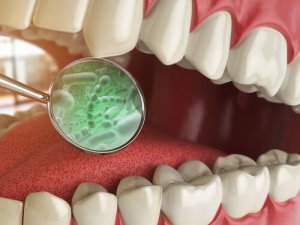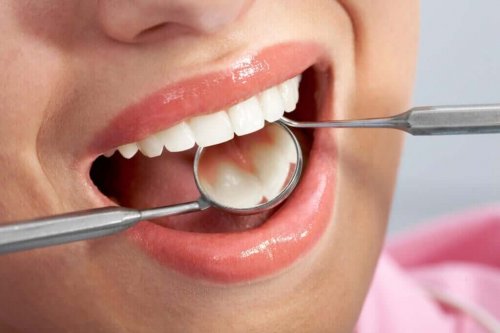What Are the Kinds of Bacteria in Your Mouth?


Written and verified by the doctor Leonardo Biolatto
There are numerous bacteria in your mouth. In fact, it’s been calculated that there are about 100 million bacteria for every millimeter of saliva. These correspond to more than 600 species of bacteria! In reality, your mouth has the perfect conditions for an infinite number of microorganisms to take refuge there.
Despite all this, many of the bacteria in your mouth don’t survive long. A good part of them is attacked by the enzymes in your saliva, while another part enters your digestive system, where they are quickly destroyed.
That said, we should also mention a group of bacteria that manages to survive and ends up living in your mouth. When this happens, it can cause problems like cavities or other diseases. The best way to fight them is with good oral hygiene.
The bacteria in your mouth
Your mouth has many surfaces, and each one of them is covered in many bacteria. Some bacteria in your mouth influence the development of diseases like cavities or periodontitis. Both are risk factors for developing other, more serious conditions, like diabetes mellitus and cardiovascular diseases.
The composition and concentration of bacteria in your mouth depend on several factors:
- Availability of nutrients
- Temperature
- Oxygen concentration
- Anatomic features
- Exposure to immunological factors
Bacteria in the mouth, along with other microorganisms, are known as oral microbiota. This population isn’t fixed, but is constantly changing, even due to factors as simple as yawning, kissing, or eating certain foods.
In general, aerobic and anaerobic bacteria dominate your mouth, both gram-positive and gram-negative. Among these, the genera Lactobacillus, Actinobacillus, Staphylococcus, and Streptococcus stand out.
We’ll take a more detailed look below.

Keep reading: 5 Habits to Help You Take Care of Your Dental Health
Saliva and bacteria
In your saliva, there are mainly facultative anaerobic gram-positive cocci, which make up about 44% of your bacterial population. These are followed by strict anaerobic gram-negative cocci, which make up about 15% of your bacterial population. Gram-positive facultative anaerobic bacilli make up a similar percentage.
Factors like loss of teeth, and diseases like gingivitis, alveolitis, or periodontitis, can cause changes in your saliva’s microbiota. Smoking and insufficient hygiene can also affect.
Buccal mucosa
In your buccal mucosa the following types of bacteria are most common:
- Firmicutes – mainly those of the genera Streptococcus and Veillonellas
- Proteobacteria – especially Neisseria
- Bacteroides – Prevotella
- Actinobacteria – Micrococcineae
Good hygiene in your buccal mucosa can prevent colonization by several different types of bacteria. According to some studies, the bacteria in your buccal mucosa may be involved in some types of cancer.
Bacteria on your teeth
If your teeth don’t have cavities, the most common bacteria you’ll find there are:
- Campylobacter
- Granulicatella
- Kingella
- Leptotrichia
- Streptococcus – especially Streptococcus sanguinis
Likewise, the following are present, especially in adults: Haemophilus parainfluenza, Gemella haemolysans, Slackia exigua, and Rothia species.
Overall, your teeth are surfaces that promote the formation of biofilms. These biofilms can do different things based on several factors. Some bacteria like Streptococcus mutans, Actinomyces y Lactobacillus influence the formation of cavities and periodontitis.

Also, read: Care After Getting Your Wisdom Teeth Pulled
Gums and bacteria
Alsa, a biofilm can form on your gums, which promotes diseases like gingivitis. If your gums are healthy, the most common microorganisms are proteobacteria. Typically, this includes gammaproteobacteria of the genus Acinetobacter, Haemophilus, and Moraxella. However, when you have a health problem you can also find Streptococcus, Granulicatella y Gemella there.
Also, on the surface of the biofilm on your gums there may be Treponema denticola along with Porphyromonas gingivalis and Tannerella forsythia. Likewise, there can be viruses and, sometimes, microorganisms like fungus. However, mouth diseases change what bacteria are found there.
Bacteria on the tongue
The biofilm that forms on your tongue is also dynamic and hosts many of the bacteria in your mouth. Overall, approximately 45% are facultative anaerobic gram-positive cocci. This includes Streptococcus salivarius, followed by Streptococcus mitis, streptococci from the milleri group, and Streptococcus mucilaginosus.
Plus, you can also find strict anaerobic gram-negative cocci and gram-positive facultative anaerobic bacilli. Also, there might be a smaller percentage of diverse species of the genera Lactobacillus, Neisseria, Fusobacterium y Haemophilus.
On the top of the tongue of people with halitosis, you can find Fusobacterium nucleatum, Porphyromonas gingivalis, and Tannerella forsythia.
Amazingly, there can be so much life in our mouths!
Prevent pathogenic bacteria in your mouth
Oral hygiene is the key to preventing pathogenic microorganisms that can affect your mouth. Likewise, regular visits to the dentist allow you to identify risk factors and diseases as they are starting, allowing you to stop them before they cause permanent damage.
If you have any questions or if it’s been a long time since you last had your mouth checked, make an appointment soon!
All cited sources were thoroughly reviewed by our team to ensure their quality, reliability, currency, and validity. The bibliography of this article was considered reliable and of academic or scientific accuracy.
- Cruz Quintana, S. M., Díaz Sjostrom, P., Arias Socarrás, D., & Mazón Baldeón, G. M. (2017). Microbiota de los ecosistemas de la cavidad bucal. Revista Cubana de Estomatología, 54(1), 84-99.
- Ortega Fernández, Omar. Estudio de la microbiota oral y de las complicaciones respiratorias de la disfagia orofaríngea: fisiopatología, diagnóstico y tratamiento de los factores de riesgo de la disfagia orofaríngea y la neumonía aspirativa en pacientes de edad avanzada. Universitat Autònoma de Barcelona,, 2016.
- Cruz, Miguel, et al. “Factores de riesgo de cáncer bucal.” Revista Cubana de Estomatología 53.3 (2016): 128-145.
This text is provided for informational purposes only and does not replace consultation with a professional. If in doubt, consult your specialist.








